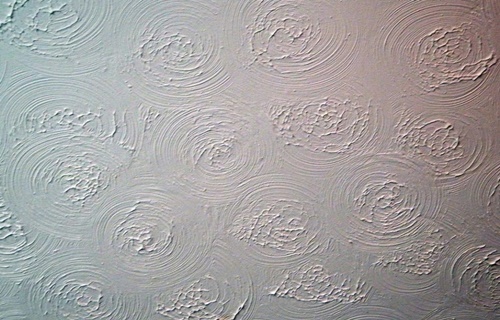Asbestos in Interior Decorations: Artex Ceilings

In the last century, asbestos was "the miracle material" favored by the building industry because it was cheap, and its fibers gave construction products strength and durability. As a consequence, the majority of the houses in the U.S. were built with materials containing asbestos, resulting in thousands of families suspected of living with the toxin under their roofs even these days.
Asbestos fibers were strengtheners in some older homes' plaster walls, acoustic insulation, or fireproofing applications and were mixed in a plethora of building materials before being banned:
- drywall
- ceiling and floor tiles
- insulation
- sheet roofing
- cement board
In the 1970s and 1980s, it was a decoration hype to create patterns and swirls using Artex, a coating notorious for containing asbestos. Even though Artex is just one brand of textured surface coating, the name now generally describes finishes containing asbestos. Unlike smooth plaster ceilings, Artex could be applied thanks to the asbestos fibers in a way that allowed the plasterer or decorator to create texture and pattern it. Standard designs included swirls, stipples, fans, shells, or simply a 'bobbly' finish.
Asbestos was still legal when Artex was popular, so much of the Artex used during that period contained asbestos fibers. To further complicate things, asbestos-free coatings were available from the late 1970s, so identifying the toxic mineral in the textured coating in your home becomes complicated. However, because it's virtually impossible to tell if asbestos is present without testing, any Artex applied before the ban should be assumed to contain asbestos.
Although the quantity of asbestos in Artex is relatively low, it poses a health risk, as no amount of asbestos exposure is safe. The coating was made with chrysotile or white asbestos, which is currently present in 95% of old buildings all over the US. Exposure to its fibers accounts for approximately 75% of asbestos-related cancer cases.
Asbestos in finishes on the ceilings of bedrooms and living areas is encased in the product matrix and is not a threat to your health until left undamaged. Construction work, fixing something to the wall or ceiling with drilling or sanding of the material will disturb it and release microscopic asbestos particles in the air - an imminent risk of asbestos exposure. The tiny airborne asbestos fibers form a fine dust that can linger for hours in the air, and if inhaled, they can cause life-threatening illnesses.
Asbestos-containing textured coatings applied both internally and externally to older properties were known in the construction industry under trade names like:
- Artex
- Marblecoat
- Newtex
- Pebblecoat
Because it's impossible to know if Artex contains asbestos just from a visual assessment, the only safe approach is to test the material. Homeowners planning construction or maintenance work should consider that Artex will likely be disturbed. A refurbishment and demolition asbestos survey will identify if asbestos is present. If the toxic material is found, it must be addressed and either removed or protected before work can commence. A licensed contractor can handle asbestos materials by safely and professionally removing and disposing of them. Still, if you have to act on your own, taking precautions following a DIY asbestos removal method is recommended.
